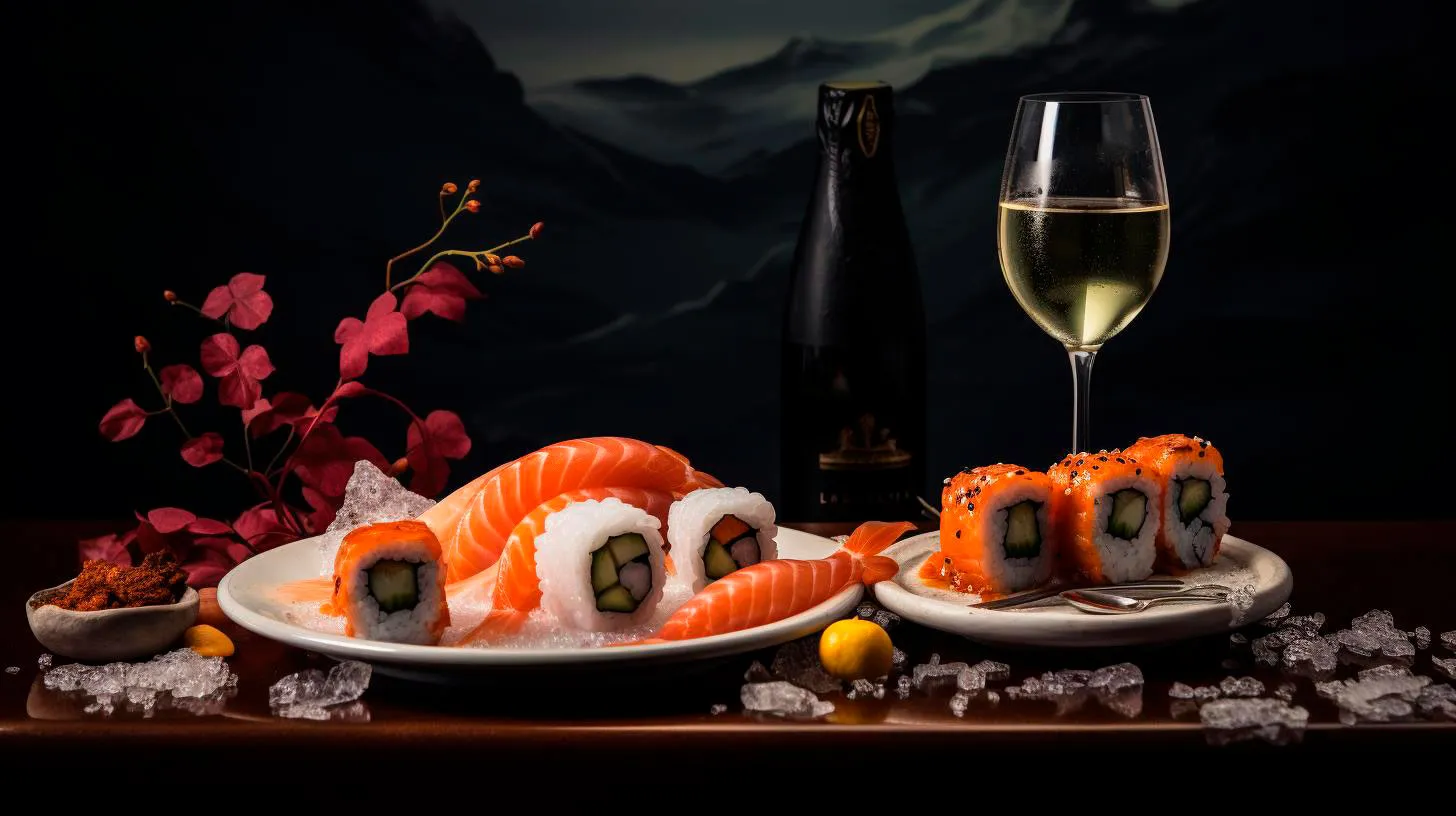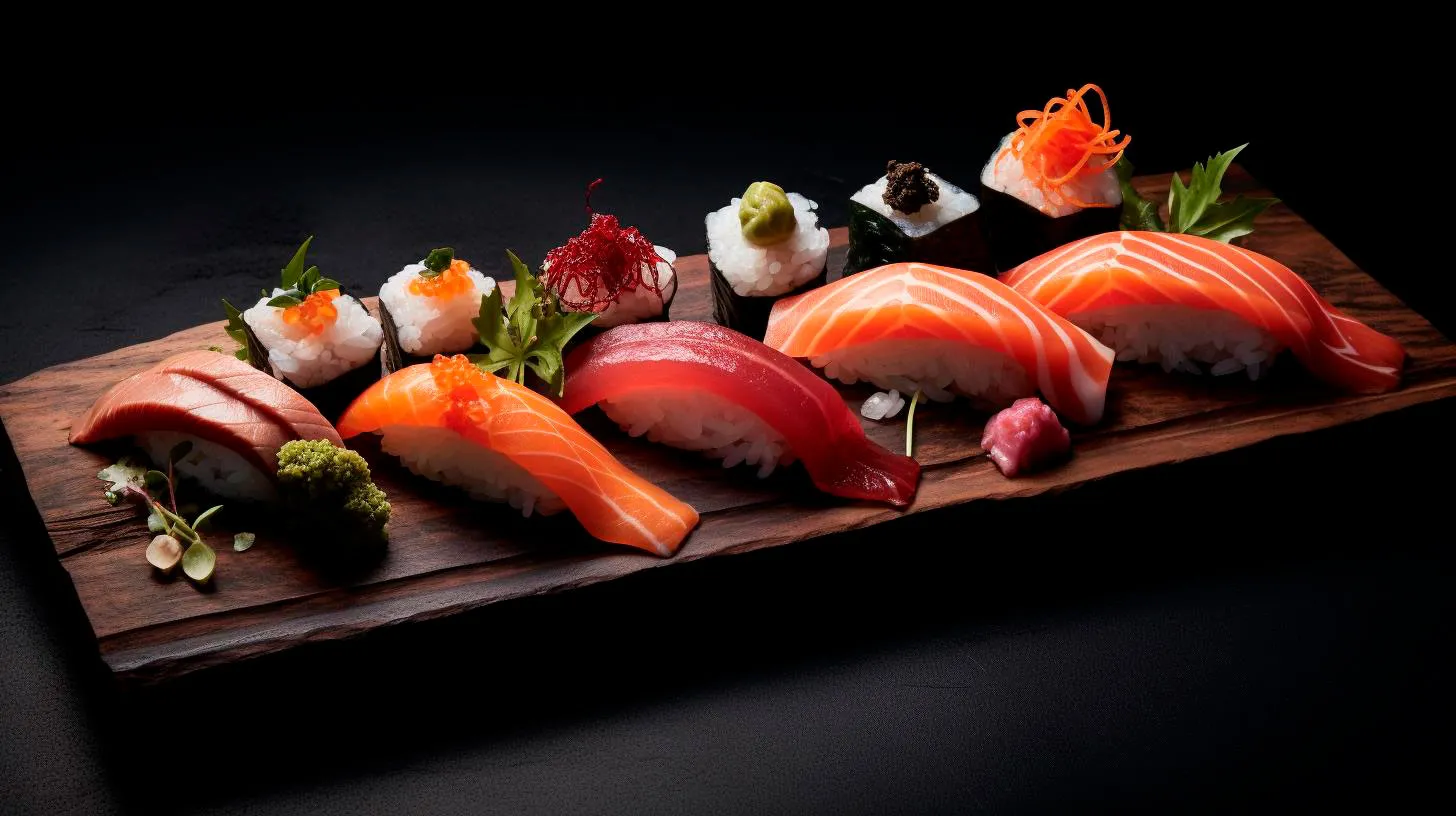Sushi: A Culinary Evolution
In this article, we will take a closer look at the fascinating journey of sushi and how it has become an integral part of global culinary culture.
The Origins of Sushi
Sushi, as we know it today, traces its origins back to Japan. However, its roots can be found in ancient China. In the 7th century, the Chinese started preserving fish in fermented rice, which was discarded before eating. This innovative technique helped to ferment the fish and extend its shelf life. It was only in the 8th century that this practice made its way to Japan through Buddhist monks returning from their travels.
In Japan, sushi continued to evolve. During the Muromachi period (1336-1573), vinegar was introduced to the rice, replacing the time-consuming fermentation process. This new method allowed sushi to be prepared and consumed quickly, making it an ideal snack for busy Japanese city dwellers.
The Modernization of Sushi
In the early 19th century, Tokyo (known as Edo at the time) witnessed a major transformation in the sushi-making process. A chef by the name of Hanaya Yohei discovered that adding a piece of raw fish on top of a small ball of seasoned rice enhanced the flavor and texture. This innovation led to the birth of nigiri sushi, which is now one of the most popular sushi varieties worldwide.
As Japan opened up to the Western world in the late 19th century, sushi began to gain international recognition. However, it wasn’t until the 1960s that sushi started gaining traction in the United States. Sushi restaurants popped up in major cities, introducing Americans to this unique Japanese delicacy.
The Art of Sushi
What sets sushi apart from other dishes is not just its delicious taste but also the artistry behind its preparation. Traditional sushi chefs, known as itamae, undergo years of training to perfect their skills. From selecting the freshest ingredients to crafting each piece with precision and care, the mastery of sushi-making is truly remarkable.
Sushi has also become a form of art on the plate. Chefs create visually stunning presentations, showcasing the natural colors and textures of the ingredients. From elegantly arranged sashimi to intricately rolled maki, every sushi creation is a feast for the eyes.
The Health Benefits of Sushi
Beyond its exquisite taste and craftsmanship, sushi also offers numerous health benefits. Here are some key takeaways:
- Sushi is low in calories: As most sushi varieties consist of raw fish, vegetables, and rice, they are generally low in calories, making it a healthier option for those watching their weight.
- High in omega-3 fatty acids: Raw fish used in sushi, such as salmon and tuna, are packed with omega-3 fatty acids, known for their heart-healthy benefits.
- A good source of protein: Sushi provides a good amount of protein, essential for muscle repair and growth.
- Rich in vitamins and minerals: Sushi is often accompanied by pickled ginger, wasabi, and seaweed, which are excellent sources of vitamins and minerals.
The Global Influence of Sushi
Sushi has transcended cultural boundaries and is now enjoyed by people all over the world. Today, sushi restaurants can be found in nearly every major city, catering to a diverse range of palates. Its popularity has even led to unique fusion creations such as sushi burritos and sushi burgers.
The sushi industry has also experienced substantial growth over the years. According to research firm IBISWorld, the sushi restaurant market in the United States alone was valued at $22 billion in 2020, with a projected annual growth rate of 3.1% from 2021 to 2026.
Key Takeaways
To sum it all up, here are the key takeaways of sushi’s evolution:
- Sushi originated in China and evolved in Japan over centuries.
- Modern sushi techniques were developed during the Edo period.
- Sushi gained global popularity in the 20th century, particularly in the United States.
- Itamae chefs are highly skilled artisans who create sushi masterpieces with precision.
- Sushi offers health benefits such as being low in calories and high in omega-3 fatty acids.
- The sushi industry is thriving, with significant market growth projected.
From humble beginnings to becoming a global culinary sensation, sushi’s journey is a testament to the power of innovation and cultural exchange. Whether you’re a sushi aficionado or trying it for the first time, the artistry, flavors, and health benefits of sushi make it an unparalleled dining experience.
From Traditional to Avant-Garde: Exploring Sushi Artistic Innovations
A Fusion of Tradition and Modernity
While sushi traces its roots back to ancient Japan, it has gradually adapted to contemporary tastes, resulting in a fusion of tradition and modernity. Today, sushi chefs around the world are not only focusing on taste but also incorporating innovative techniques and creative presentations.
- Sushi Roll Art: Traditional sushi rolls frequently feature fish, vegetables, and rice wrapped in seaweed. However, sushi roll artists are now pushing the boundaries by creating intricate and visually stunning designs using a mix of vibrant ingredients. From animal shapes to artistic patterns, these edible artworks are sure to impress.
- Nigiri Innovations: Nigiri, a type of sushi consisting of a small mound of rice topped with fresh seafood, is undergoing artistic transformations to enhance both taste and aesthetics. Chefs are experimenting with various textures, flavors, and garnishes to offer a unique dining experience. Delicate and beautifully garnished nigiri is a feast for both the eyes and the palate.
- Sashimi Art: Sashimi, thin slices of raw fish or seafood, is traditionally served in a simple and elegant manner. However, innovative chefs are now presenting sashimi in visually appealing arrangements, showcasing their artistic skills. These visually stunning sashimi arrangements elevate the dining experience by adding an artistic touch.
Advantages of Sushi Artistic Innovations
The advent of sushi artistic innovations not only enhances the aesthetic appeal of sushi but also provides several advantages:
- Novel Dining Experience: Sushi artistic innovations offer a unique and exciting dining experience for food enthusiasts. The artistry behind the sushi creations adds an element of surprise and delight, making each bite memorable.
- Increased Accessibility: By embracing creativity, sushi chefs have made this traditional cuisine more accessible. Sushi artistic innovations have attracted wider audiences, including those who may have previously been hesitant to try sushi.
- Global Recognition: The imaginative and visually striking nature of sushi artistic innovations has contributed to its global recognition. Social media platforms and food blogs have played a significant role in showcasing these beautiful creations, making sushi an art form that reaches far beyond its native culture.
- Revitalizing Tradition: Sushi artistic innovations breathe new life into traditional cuisine. By preserving its roots while embracing modern creativity, sushi remains relevant and dynamic, appealing to both traditionalists and those seeking new gastronomic experiences.
The Key Takeaways
Sushi has transformed from a traditional delicacy to a platform for artistic expression. The fusion of tradition and modernity has birthed sushi artistic innovations, captivating the hearts and taste buds of people worldwide. Culinary artists continuously explore new techniques and ingredients, resulting in extraordinary sushi creations that are both visually stunning and delicious.
Key takeaways from the fascinating world of sushi artistic innovations:
- Sushi artistic innovations combine tradition with modern creativity.
- Chefs experiment with sushi rolls, nigiri, and sashimi to create visually stunning edible artworks.
- Sushi artistic innovations provide a novel dining experience and increase accessibility.
- Social media has played a significant role in promoting and showcasing sushi artistic creations.
- By revitalizing tradition, sushi remains dynamic and appeals to a wide range of audiences.
So, the next time you indulge in sushi, take a moment to appreciate the extraordinary artistry that lies before you. Sushi offers not only a feast for your taste buds but also a visually captivating experience that bridges the gap between tradition and avant-garde creativity.
Sashimi to Nigiri: Unraveling the Symbolism of Sushi
In this article, we will delve into the world of sushi, exploring its various forms and uncovering the hidden meanings behind each delectable piece.
The Essence of Sushi
Sushi, originating from Southeast Asia more than 2,000 years ago, has evolved significantly over time. It is a culinary art that harmonizes the flavors of carefully selected fish, seafood, rice, and other ingredients, creating a perfect balance of taste and texture. Beyond the mere act of eating, sushi also represents a harmonious relationship between humans and nature. Every element in a sushi dish is chosen with utmost care, bringing together the essence of seasonality, sustainability, and precision.
The Different Forms of Sushi
Sushi comprises various forms, each distinct in its presentation and ingredients. Let’s explore some of the most popular types:
- Nigiri: The most commonly known form of sushi, nigiri consists of vinegared rice topped with a slice of fresh fish or seafood. It is a perfect amalgamation of flavors and textures, allowing the diner to savor the essence of the ingredients.
- Sashimi: Sashimi refers to thin slices of raw fish or seafood, served without rice. It highlights the natural flavor and texture of the fish, requiring supreme skill in cutting and presentation.
- Maki: Maki rolls are created by wrapping fish, vegetables, and rice in a sheet of seaweed (nori) and then slicing them into bite-sized pieces. The colorful and visually appealing rolls offer a delightful blend of tastes and textures.
- Temaki: Temaki refers to hand-rolled sushi, where the ingredients are wrapped in a cone-shaped piece of nori. It allows for a customized dining experience, as the diner can choose the fillings according to their preferences.
The Symbolism Behind Sushi
Sushi goes beyond its culinary appeal and embodies several symbolic elements associated with Japanese culture. Let’s unravel some of the hidden meanings:
Presentation:
In Japanese cuisine, presentation is as important as taste. The meticulous arrangement of sushi showcases the chef’s skills and attention to detail. The vibrant colors, artistic patterns, and graceful plating reveal the harmony between aesthetics and flavor.
Freshness and Seasonality:
Sushi is a celebration of the freshest ingredients. The emphasis on seasonal produce ensures that each dish offers the peak flavors and textures of the ingredients. The Japanese have a deep appreciation for nature’s bounty, and sushi pays homage to this connection.
Minimalism:
Japanese culture cherishes simplicity and minimalism, and sushi reflects this principle. The use of minimal ingredients allows the natural flavors to shine, without overwhelming the palate. Each bite encapsulates the essence of simplicity and elegance.
Sharing and Togetherness:
Sushi is often enjoyed in a communal setting, encouraging sharing and togetherness. The act of gathering around a sushi bar or dining table fosters a sense of community, strengthening bonds and creating memorable moments. It symbolizes the importance of shared experiences and connection.
Key Takeaways
Understanding the symbolism behind sushi enables us to appreciate this culinary art on a deeper level. Here are some key takeaways to remember:
- Sushi is a harmonious balance of flavors, textures, and aesthetics.
- It represents the relationship between humans and nature, emphasizing seasonality and sustainability.
- Varieties like nigiri, sashimi, maki, and temaki offer diverse dining experiences.
- Sushi showcases the importance of presentation, freshness, minimalism, and sharing.
As you embark on your next sushi adventure, remember the hidden meanings that lie within each piece. Savor not just the taste but also the cultural significance that makes sushi an extraordinary culinary experience.
Preserving Traditions: The Significance of Sushi in Japanese Culture
A Brief History of Sushi
Sushi, which literally translates to “sour-tasting,” originated in Southeast Asia over 2000 years ago. It first made its way to Japan in the 8th century, primarily as a means of preserving fish by fermenting it with rice and salt. This technique allowed the fish to be kept for months without spoiling, which was crucial in an era without refrigeration.
Over time, sushi evolved into different forms, with the most well-known being nigiri-zushi (hand-pressed sushi) and maki-zushi (rolled sushi). The Edo period (17th to mid-19th century) brought significant changes to sushi, as street food stalls known as “sushiya” became popular. The introduction of soy sauce and wasabi further enhanced the flavors and presentation of sushi.
The Cultural Significance of Sushi
Sushi has transcended its role as merely a dish and has become an integral part of Japanese culture. Here are some key aspects that showcase its significance:
1. Symbol of Japanese Identity
- Sushi embodies the essence of Japanese culture, reflecting the country’s focus on precision, elegance, and simplicity.
- It represents the close relationship between the Japanese people and the sea, as seafood is a staple in their diet.
2. Artistry in Presentation
- Sushi chefs dedicate years to mastering their craft, focusing not only on the taste but also on the visual appeal of the dish.
- The meticulous arrangement of colors, textures, and flavors showcases the aesthetic principles of Japanese art and the concept of “less is more.”
3. Rituals and Etiquette
- Enjoying sushi involves a set of rituals and etiquette that are deeply ingrained in Japanese society.
- Respecting the chef, using chopsticks properly, and eating sushi in one bite are just a few examples of the etiquette associated with this culinary tradition.
4. Social Bonding
- Sushi has become a social food, often enjoyed with family, friends, or colleagues.
- Sharing a meal of sushi creates a sense of camaraderie, fostering connections and deepening relationships.
Key Takeaways
Sushi holds a special place in Japanese culture, representing their identity, artistry, and social bonding. As the world embraces this culinary gem, let us remember its deep-rooted traditions and the cultural significance it holds. Whether you’re a sushi aficionado or just beginning to explore this remarkable cuisine, experiencing the essence of Japan through sushi is an unmissable opportunity.


